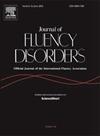Assessment and treatment of acquired stuttering: A single subject study
IF 2.1
3区 医学
Q1 AUDIOLOGY & SPEECH-LANGUAGE PATHOLOGY
引用次数: 0
Abstract
Purpose
Acquired stuttering typically has an onset in adulthood and can be neurogenic or functional (DSM-5)/dissociative (ICD-11) in nature. Differential diagnosis may not always be straightforward. Unfortunately, there is a lack of systematic prospective research providing detailed assessment and treatment information in this area. This single subject case study provides a detailed overview of the assessment and diagnostic process followed with a client referred with acquired stuttering, treatment techniques used and their outcomes.
Method
This single case study involved a client with a 9-month history of acquired
stuttering who participated in 2 baseline assessment sessions followed by 8 treatment
sessions over two weeks. Treatment was tailored to the needs of the participant and based on assessment findings indicating fluency improvements during singing. Five follow up sessions were held in the 6 months post-treatment to monitor progress and maintenance. Speech disfluencies were coded, and questionnaires were used to assess impact of stuttering.
Results
Baseline assessment results supported a diagnosis of acquired functional stuttering. Following treatment, the frequency of syllables stuttered reduced in all speech tasks: conversation, picture description and reading. The participant regained previous natural fluency, showed overall quality of life improvements and was able to resume work shortly after treatment.
Conclusions
This acquired functional stuttering report showed that while initial differential diagnosis may be difficult, comprehensive assessment facilitates this process and may guide treatment decisions. Treatment led to a regain of previous fluency and a significant improvement in quality of life.
获得性口吃的评估和治疗:一项单受试者研究
目的:获得性口吃通常在成年期发病,本质上可能是神经源性或功能性(DSM-5)/分离性(ICD-11)。鉴别诊断可能并不总是直截了当的。不幸的是,在这一领域缺乏系统的前瞻性研究提供详细的评估和治疗信息。这个单一主题的案例研究提供了评估和诊断过程的详细概述,随后与一个客户提到获得性口吃,使用的治疗技术和他们的结果。方法本个案研究涉及一位有9个月的获得性口吃病史的患者,他参加了2次基线评估,随后在2周内进行了8次治疗。治疗是根据参与者的需要量身定制的,并基于评估结果表明,在唱歌期间流利性得到改善。治疗后6个月内进行了5次随访,以监测进展和维持情况。语言不流利被编码,并使用问卷来评估口吃的影响。结果基线评估结果支持获得性功能性口吃的诊断。经过治疗后,在所有言语任务中,包括对话、图片描述和阅读,出现音节口吃的频率都有所降低。参与者恢复了先前的自然流畅性,显示出整体生活质量的改善,并且能够在治疗后不久恢复工作。结论:这篇获得性功能性口吃报告表明,虽然最初的鉴别诊断可能很困难,但全面的评估有助于这一过程,并可能指导治疗决策。治疗使患者恢复了以前的流利程度,生活质量也有了显著改善。
本文章由计算机程序翻译,如有差异,请以英文原文为准。
求助全文
约1分钟内获得全文
求助全文
来源期刊

Journal of Fluency Disorders
AUDIOLOGY & SPEECH-LANGUAGE PATHOLOGY-REHABILITATION
CiteScore
3.70
自引率
14.30%
发文量
23
审稿时长
>12 weeks
期刊介绍:
Journal of Fluency Disorders provides comprehensive coverage of clinical, experimental, and theoretical aspects of stuttering, including the latest remediation techniques. As the official journal of the International Fluency Association, the journal features full-length research and clinical reports; methodological, theoretical and philosophical articles; reviews; short communications and much more – all readily accessible and tailored to the needs of the professional.
 求助内容:
求助内容: 应助结果提醒方式:
应助结果提醒方式:


